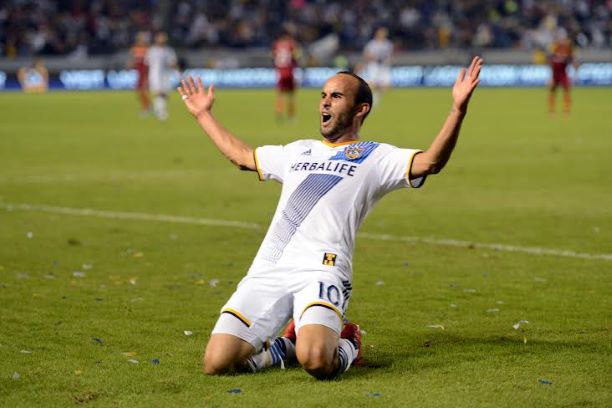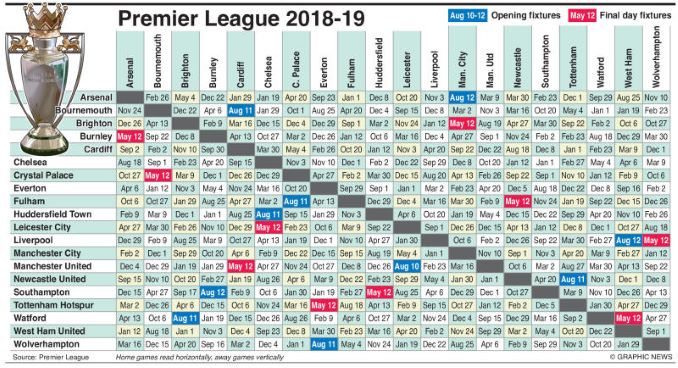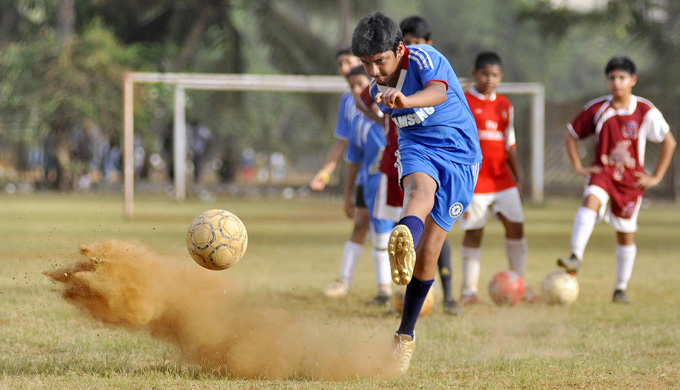Can the Indian Super League wake a sleeping giant?
Can the Indian Super League wake a sleeping giant?

Can the Indian Super League wake a sleeping giant?
By Greg Lea
An initial glance at the latest FIFA World Rankings yields few surprises: world champions Germany sit top while Argentina, the runners-up in Brazil, are second. However, as you scroll further down the list, one name sticks out above all others. Way down in 158th place, below Puerto Rico, Curacao and Kyrgyzstan, are India.
In Soccernomics, Simon Kuper and Stefan Szymanski argue that population, football experience and per capita income are the best indicators of the strength of a national side. With 1.2 billion people and the world’s tenth largest economy, India – all set for the launch of the Indian Super League on Sunday – are undoubtedly the planet’s biggest underachievers.
Football was introduced to the Indians by British colonists in the mid-nineteenth century to provide a form of entertainment for the armed forces, who competed with each other in games across the country. The Durand Cup – the third oldest competition in world football behind the FA and Scottish equivalents – was created in 1888, around the same time that clubs began to spring up in Calcutta, the capital of British India. In 1937, the All Indian Football Federation (AIFF) was established and, when independence was accomplished ten years later, the governing body quickly gained FIFA recognition.
Moderate success followed. India made their first official tournament appearance at the London Olympics in 1948, where they were narrowly defeated by a France side who required an 89th minute goal to seal a 2-1 victory in a game which saw the Indians miss two penalties and play in bare feet. Two years later, India were due to be Asia’s sole representative at the World Cup in Brazil, but withdrew due to travel costs (the story that they refused to participate because of FIFA’s insistence that they wear boots is actually false, a myth propagated by the AIFF to cover up what was, in hindsight, a terrible decision).
Nevertheless, gold medals were attained at the Asian Games in 1951 and 1962, and India placed fourth in the 1956 Olympics, memorably defeating hosts Australia in Melbourne in the quarter-finals. Under the management of Abdul Rahim, India were increasingly seen as the continent’s best side.
It would not last. Rahim, regarded as a real football scholar, died from cancer in 1963, and India’s rise was stopped in its tracks. Asian Cup runners-up in 1964, they failed to qualify again until the 1984 edition, when they finished bottom of their five-team group and were eliminated without scoring a goal. Results dipped just as the likes of Iran, Kuwait and South Korea started to come to the fore, yet it was a non-footballing event that provided the most decisive blow to the sport in the country. In 1983, India won the Cricket World Cup.
The impact was colossal. Cricket instantly became the face of India’s growth and prosperity and was now undoubtedly the nation’s most popular sport. Politicians recognised its worth and the state began to invest heavily, while businesses scrambled to land potentially lucrative sponsorship deals. Inspired by the underdog story of India overcoming their former colonists England in the last four and the West Indies in the final, children across the nation decided to pick up a bat and ball to try and replicate their heroes. ‘The 1983 World Cup’, says team captain Kapil Dev, ‘changed the entire sport in our country’.
Football was suddenly emphatically second-best, and its subordinate status persists today. Cricket, seen as India’s greatest chance of global success, receives substantially more government funding, and the resultant difference in infrastructure between the two sports is significant. Even at the highest level, football stadiums are grossly inadequate: the national team has had no permanent home since 2011 after multiple arenas were found to be in breach of FIFA’s health and safety guidelines, while communal grass pitches are scarce and extremely prone to flooding, particularly in the monsoon season. For the most part, it remains difficult for the game to secure private investment, with firms seeing little value in associating themselves with a sport that is widely perceived to be in a deep malaise.
Although millions tune into the Premier League and La Liga every weekend, local matches have hitherto been poorly attended, a consequence of a globalised world which allows Indian fans to watch world-class talent from the comfort of their own homes. Indeed, 67 million tuned into the 2008 Champions League final between Chelsea and Manchester United, yet many Indian clubs struggle to fill their 6000-capacity stadiums, not helped by the need to stage many games during midweek afternoons because of the lack of floodlights.
Even when there is support – football is huge in the northeast, and there are significant fan bases in the states of Goa, Bangalore, Kerala and Calcutta – it is often taken for granted: the Calcutta derby between Mohun Bagun and East Bengal regularly attracts 100,000 spectators, yet the unwavering loyalty of the Calcuttans has been used as an excuse by the authorities to not update or renovate facilities and infrastructure.
While football’s popularity has clearly grown in recent years, it has not been the Indian version that has attracted attention: Barcelona shirts and Brazil flags are commonplace, but there has generally been little appetite for the substandard local product, a situation that the authorities are hoping to redress with the launch of the more glamorous Super League, which will see European stars of yesteryear such as Alessandro Del Piero, Robert Pires and David Trezeguet line up alongside homegrown talent.
The lack of a national league until 1996 certainly contributed to the widespread indifference shown towards football. By the time of the National Football League’s inauguration, cricket had firmly established itself as the nation’s principal sport, and football found it difficult to entice fans and sponsors. The division received very little attention and was replaced by the I-League in 2007 in an attempt to professionalize the game; hopes were high, particularly as the launch was accompanied by a long-term broadcast deal with Zee Sports, who secured the rights to air games throughout the country. The contract, however, was cancelled after three years, meaning the 2010-11 season went totally untelevised, and two I-League clubs were forced to fold due to financial issues and difficulties in marketing themselves to their communities.
Australia, Japan and South Korea have demonstrated the value of a strong domestic league when football is not the country’s traditional sport, but India lags some way behind, the I-League damaged by organisational problems and a general disinterest. The hope is that the Super League – which runs in the I-League’s off-season – will be a catalyst for growing interest in football generally and that once it has reached its denouement Indian locals will tune into the nation’s primary domestic competition, but the claim is arguable and it is not difficult to envisage a situation whereby the population turns back to either cricket or the major European leagues once the initial curiosity of seeing foreign starts perform on Indian soil has been satisfied.
There is also a cultural aspect to India’s footballing underachievement. Despite being one of the planet’s fastest growing economies, 33 per cent of Indians live below the international poverty line, and the nation is thought to be home to a third of the world’s poor. Rags-to-riches stories are commonplace in football, and entrenched poverty and inequality have not hindered the production of talented footballers in places like Brazil, but in India, football is not seen as a viable way out. Education is heavily emphasised, and parents tend to discourage their children from wasting their time on a sport viewed as inferior to professional roles in fields such as engineering, law and medicine.
Exceptions may be made for cricket, which is seen as a potentially fruitful career due to India’s lofty standing in the world game, but with extensive parental pressure leading to extra-curricular tutoring and homework, sport remains a mere luxury to many Indian youngsters. Indeed, something of a catch-22 exists: football is not seen as an expedient path out of poverty because of a lack of success stories, but talented Indian footballers can only emerge if the game is held in a higher regard.
Despite all of this, some promising signs for Indian football can be found. Although there has traditionally been very little focus on youth development – the import of players from Africa and Latin America is such an embedded practice that the lengthier process of producing young Indian footballers has often been discarded –the AIFF finally seem to have recognised the importance of producing Indian youngsters: I-League clubs must now enter an under-19 team into a national league, and a recent grassroots project has seen the opening of residential academies across the country, providing excellent facilities for coaches and young players alike.
FIFA, meanwhile, has committed itself to three projects since 2001: the building of headquarters and offices for the AIFF in Dehli, the construction of pitches in the northeast and south, and the creation of regional academies focused on producing players in the under-14 and under-15 age group. India’s potential has not been lost on European giants either, with Manchester United, Liverpool and Barcelona all forming links with academies in the Southern Asian state in the past few years.
Perhaps the biggest boost to football in India would be a successful export akin to Japan’s Shunsuke Nakamura, South Korea’s Park Ji-Sung or Australia’s Tim Cahill. Sunil Chhetri, the best of India’s current crop, signed for Sporting Lisbon reserves in 2012 but played only three times before returning home; Baichung Bhaita, who joined Bury in 1999, and Mohammed Salim in the 1930s are the only other Indians to play professionally abroad. Talented footballers do not just emerge in isolation, however, for they are reliant on the facilities, conditions and environment in which they find themselves, and further investment is required in order to give youngsters the best chance of prospering. It is to be hoped that the launch of the Super League does not come at the expense of bottom-up initiatives: the nascent competition based on the model of cricket’s IPL must work in conjunction with sustained youth development for India to begin to realise its potential.
India will not be represented at the Asian Cup in Australia in January, failing to qualify where the likes of Bahrain, Oman and Palestine succeeded. A 27-year absence from the competition was ended by an appearance at the 2011 edition in Qatar, where the Blue Tigers lost all three group games, conceding 13 goals. Nevertheless, the squad received a warm welcome on their return home, special praise reserved for goalkeeper Subrata Pal after a string of impressive saves and performances.
Fellow participants may tend to be very week but triumphs at the Nehru Cup in 2007, 2009 and 2012 offer small signs of encouragement, and FIFA’s decision to award India with the right to host the 2017 under-17 World Cup could serve as a real boost to the country’s football culture and youth development.
There is still a long way to go but if India can use the razzmatazz of the Super League to grow support for the game while concurrently continuing to invest at grassroots level, progress can be made. If India could punch just a quarter of their weight on the international stage, they would be a force to be reckoned with. Kyrgyzstan, you feel, would not stand a chance.
This piece was written by A Football Report contributor Greg Lea. Comments below please.










